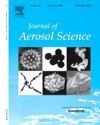The impact of environmental aging processing on bioaerosol detection using circular intensity differential scattering (CIDS)
IF 2.9
3区 环境科学与生态学
Q2 ENGINEERING, CHEMICAL
引用次数: 0
Abstract
Circular intensity differential scattering (CIDS) has recently been used to discriminate biological from non-biological particles based on direct detection of nucleic acids in single individual particles. Most sensors that discriminate biological from non-biological particles are based on laser-induced fluorescence (LIF). Although LIF can be used to sample and analyze aerosol particles continuously, but its detection signatures are altered by different atmospheric conditions, complicating the interpretation of LIF sensor data. Since CIDS signals are based on the chirality of nucleic acids, environmental damage to nucleic acid is not likely to impact the CIDS return in the same way that it impacts the LIF signal. To test this hypothesis, MS2 aerosol particles were generated and exposed to both simulated sunlight and ozone in a Biological Aerosol Reaction Chamber (Bio-ARC). These rapidly aged particles were measured by a Wideband Integrated Bioaerosol Sensor (WIBS-4a), which measures aerosol fluorescence excited at 280 and 370 nm, and a novel aerosol measurement system that relies on CIDS. The impact of this simulated aging on both LIF and the CIDS returns will be evaluated. Since LIF and CIDS returns were impacted differently by environmental aging processes, the results showed a greater stability of CIDS measurements and highlighted its potential application in rapid detection and characterization of bioaerosols.
环境老化过程对循环强度差分散射(CIDS)检测生物气溶胶的影响
圆形强度微分散射(CIDS)最近被用于区分生物和非生物颗粒,基于直接检测单个颗粒中的核酸。大多数区分生物和非生物颗粒的传感器都是基于激光诱导荧光(LIF)。虽然LIF可以用于连续采样和分析气溶胶颗粒,但其检测特征会因不同的大气条件而改变,这使得LIF传感器数据的解释变得复杂。由于CIDS信号是基于核酸的手性,因此对核酸的环境破坏不太可能像影响LIF信号那样影响CIDS回报。为了验证这一假设,在生物气溶胶反应室(Bio-ARC)中产生MS2气溶胶颗粒并将其暴露于模拟阳光和臭氧中。这些快速老化的颗粒通过宽带集成生物气溶胶传感器(WIBS-4a)测量,该传感器测量280和370 nm激发的气溶胶荧光,以及依赖于CIDS的新型气溶胶测量系统。将评估这种模拟老化对LIF和CIDS回报的影响。由于LIF和CIDS的回报受到环境老化过程的不同影响,结果表明CIDS测量结果具有更高的稳定性,并突出了其在生物气溶胶快速检测和表征中的潜在应用。
本文章由计算机程序翻译,如有差异,请以英文原文为准。
求助全文
约1分钟内获得全文
求助全文
来源期刊

Journal of Aerosol Science
环境科学-工程:化工
CiteScore
8.80
自引率
8.90%
发文量
127
审稿时长
35 days
期刊介绍:
Founded in 1970, the Journal of Aerosol Science considers itself the prime vehicle for the publication of original work as well as reviews related to fundamental and applied aerosol research, as well as aerosol instrumentation. Its content is directed at scientists working in engineering disciplines, as well as physics, chemistry, and environmental sciences.
The editors welcome submissions of papers describing recent experimental, numerical, and theoretical research related to the following topics:
1. Fundamental Aerosol Science.
2. Applied Aerosol Science.
3. Instrumentation & Measurement Methods.
 求助内容:
求助内容: 应助结果提醒方式:
应助结果提醒方式:


